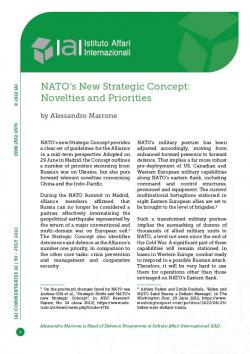NATO’s New Strategic Concept: Novelties and Priorities
NATO’s new Strategic Concept provides a clear set of guidelines for the Alliance in a mid-term perspective. Adopted on 29 June in Madrid, the Concept outlines a number of priorities stemming from Russia’s war on Ukraine, but also puts forward relevant novelties concerning China and the Indo-Pacific.
During the NATO Summit in Madrid, alliance members affirmed that Russia can no longer be considered a partner, effectively internalising the geopolitical earthquake represented by the return of a major conventional and multi-domain war on European soil.[1] The Strategic Concept also identifies deterrence and defence as the Alliance’s number one priority, in comparison to the other core tasks: crisis prevention and management and cooperative security.
NATO’s military posture has been adjusted accordingly, moving from enhanced forward presence to forward defence. That implies a far more robust pre-deployment of US, Canadian and Western European military capabilities along NATO’s eastern flank, including command and control structures, personnel and equipment. The current multinational battaglions stationed in eight Eastern European allies are set to be brought to the level of brigades.[2]
Such a transformed military posture implies the earmarking of dozens of thousands of allied military units to NATO, a level not seen since the end of the Cold War. A significant part of these capabilities will remain stationed in bases in Western Europe, combat ready to respond to a possible Russian attack. Therefore, it will be very hard to use them for operations other than those envisaged on NATO’s Eastern flank.
Accordingly, NATO’s defence plans will increasingly focus on “high-intensity, multi-domain warfighting against nuclear-armed peer-competitors”,[3] while less attention is directed at crisis management, counter-insurgency or stability operations. This in turn will significantly influence the capability development and procurement of the allies towards collective defence and conventional conflicts, in line with what is already happening in Germany since March 2022.[4]
The space and cyber domains are fully integrated in NATO’s new deterrence and defence posture. Indeed, “a single or cumulative set of malicious cyber activities; or hostile operations to, from, or within space; could reach the level of armed attack and could lead the North Atlantic Council to invoke article 5 of the North Atlantic Treaty”[5] on collective defence. This provision is not entirely new as it reflects statements from previous allied summits.[6] Yet, its inclusion is extremely important because it gives a more stable and high-level mandate to NATO structures and allied militaries to develop doctrines and capabilities for cyber and space operations.
The Strategic Concept also considers hybrid tactics[7] through the lens of collective defence: “hybrid operations against allies could reach the level of armed attack and could lead the North Atlantic Council to invoke Article 5”.[8] Considering this combined focus on space, cyber and hybrid warfare, the message being sent to an increasingly risk-prone Russian leadership is clear: do not challenge NATO because we will react in kind.
NATO allies are also aware of the risks of losing their military edge due to China’s massive, across the board investments in new technologies and Russian niche capabilities in hypersonic weapons, for instance. This is why the Strategic Concept commits to “promote innovation and increase our investments in emerging and disruptive technologies to retain our interoperability and military edge”,[9] placing this objective under the core task of collective defence.
The reference to interoperability is important here because US innovation moves fast while Europeans lag behind due to the fragmentation of efforts. For Europeans’, therefore, NATO’s emphasis on interoperability and military edges means first and foremost cooperation, coordination and integration of industrial choices and development. This is the only way to face the Russian threat while developing and producing European technologies relevant for national and collective defence.[10]
Interestingly, compared to the 2010 Strategic Concept, the Madrid document moves arms control, disarmament and non-proliferation from the core task of cooperative security to that of collective defence. The underpinning idea is that strategic stability relies on two pillars. On the one hand, deterrence and defence. On the other, “meaningful and reciprocal political dialogue” with adversaries on arms control, non proliferation and disarmament, aimed to “reduce risk and enhance security, transparency, verification, and compliance”.[11] The first pillar has already been enhanced by decisions taken in Madrid, while the second will require a political, diplomatic and military effort by allies, first and foremost the US but also Europeans part of NATO nuclear sharing arrangements.
Compared to deterrence and defence, the core task of crisis prevention and management receives little attention however. Here, the Alliance’s approach is rather cautious and humble. The basic idea is to retain the ability to deploy and sustain crisis management operations, while investing in capacity building with vulnerable partners in NATO’s neighbourhood and beyond. Afghanistan is barely mentioned once and only in terms of lessons learned.
In recent years, the US military’s retrenchment from the Middle East and North Africa as well as Central Asia has proceeded in parallel with the French withdrawal from Mali, signalling overall trends of Western military overstretch and political fatigue. The Russian war in Ukraine has already shifted allies towards collective defence. The decisions taken in Madrid reflect this new reality within and around the Alliance.
NATO will likely continue to run the Kosovo Force in a European, permissive environment as well as the Sea Guardian mission – a modest maritime security operation in the Mediterranean Sea. That said, another takeaway from the Strategic Concept is that it confirms a watershed change for NATO: the age of large scale allied out-of-area operations died in Kabul on 31 August 2021 and was subsequently buried in Kiev on 24 February 2022.
Moving to the third core task of cooperative security, the Concept outlines two important and realistic guidelines. First, concerning enlargement, NATO’s open-door policy is implicitly reaffirmed through a rejection of any interference by third parties on the Alliance’s decisions, but no further steps are made with regards to Ukraine’s, Moldova’s or Georgia’s prospective membership. While the EU has offered candidate status to a country at war with Russia, with Russian forces likely occupying parts its territory for decades, NATO has wisely refrained from any step which would put the Alliance in direct conflict with Moscow.
The second important guideline concerns the EU, confirmed by the Madrid document as a “unique and essential partner” of NATO.[12] The Alliance commits to strengthen the strategic partnership with the Union in terms of both political consultation and increased cooperation on a number of dossiers. It “recognises the value of a stronger and more capable European defence that contributes positively to transatlantic and global security and is complementary to, and interoperable with NATO”.[13] Coupled with the appreciation of “initiatives to increase defence spending and develop coherent, mutually reinforcing capabilities”, such statement looks like an implicit endorsement for EU defence frameworks.
Still, the Madrid document states that “non-EU Allies’ fullest involvement in EU defence efforts is essential”. This position reflects the tense relations between the Union and the UK and Turkey, but can overall constitute a green light for further EU–NATO cooperation.
A fundamental novelty coming from Madrid is the attention given to the People Republic of China (PRC) and the Indo-Pacific region, mentioned for the very first time in a NATO Strategic Concept. Allies explicitly state that the “PRC’s malicious hybrid and cyber operations and its confrontational rhetoric and disinformation target Allies and harm alliance security”,[14] while accusing Beijing of striving to “subvert the rules-based international order, including in the space, cyber and maritime domains”.[15] Such accusation is coupled with a commitment to “remain open to constructive engagement with the PRC, including to build reciprocal transparency”.[16]
The Strategic Concept somehow strikes a balance between different perspectives among allies by outlining a very first common assessment. The most important follow up with regards to the Indo-Pacific is an enhancement of partnerships with like-minded countries such as Australia, Japan, New Zealand and South Korea, whose heads of government were present for the very first time in Madrid for a NATO summit. These partnerships existed before,[17] but today they assume new relevance in light of growing concern over China’s rise.
Against this backdrop, the Strategic Concept clearly de-prioritises the Middle East and North Africa, as well as the Sahel. These regions are barely cited, receiving much less attention than the Indo-Pacific, while the related NATO partnerships, the Mediterranean Dialogue and Istanbul Cooperation Initiative, are not even mentioned – neither in the document nor in the final summit communiqué. Since instability, crises and conflicts in Europe’s southern neighbourhood will not go away, the question mark left by the new NATO Strategic Concept is whether and how Europeans want and can address these challenges by themselves.
Alessandro Marrone is Head of Defence Programme at Istituto Affari Internazionali (IAI).
[1] On the profound changes faced by NATO see Andrea Gilli et al., “Strategic Shifts and NATO’s new Strategic Concept”, in NDC Research Papers, No. 24 (June 2022), https://www.ndc.nato.int/news/news.php?icode=1716.
[2] Ashley Parker and Emily Rauhala, “Biden and NATO Send Russia a Defiant Message”, in The Washington Post, 29 June 2022, https://www.washingtonpost.com/politics/2022/06/29/biden-nato-defiant-russia.
[3] NATO, NATO 2022 Strategic Concept, 29 June 2022, point 22, https://www.nato.int/strategic-concept.
[4] Elio Calcagno and Michelangelo Freyrie, “Cosa sapere della svolta tedesca su difesa e sicurezza”, in AffarInternazionali, 31 May 2022, https://www.affarinternazionali.it/?p=98394.
[5] NATO, NATO 2022 Strategic Concept, cit., point 25.
[6] See in this regard: Alessandro Marrone and Ester Sabatino, “Cyber Defence in NATO Countries: Comparing Models”, in IAI Papers, No. 21|05 (February 2021), https://www.iai.it/en/node/12727; Alessandro Marrone and Michele Nones (eds), “The Expanding Nexus between Space and Defence”, in Documenti IAI, No. 22|01 (February 2022), https://www.iai.it/en/node/14669.
[7] For a reflection on hybrid threats see, among others, Can Kasapoğlu et al., “Countering Hybrid Threats: A New NATO Core Task”, in Clingendael Spectator series: Geopolitics & Global Order, 22 June 2022, https://spectator.clingendael.org/en/node/5546.
[8] NATO, NATO 2022 Strategic Concept, cit., point 27.
[9] Ibid., point 24.
[10] Felix Arteaga et al., “To Face the Russian Threat Europeans Need to Spend Together - Not Side by Side”, in EURACTIV, 19 April 2022, https://www.euractiv.com/?p=1745658.
[11] NATO, NATO 2022 Strategic Concept, cit., point 32.
[12] Ibid., point 43.
[13] Ibid.
[14] Ibid., point 13.
[15] Ibid.
[16] Ibid., point 14.
[17] For a comprehensive analysis of NATO partnerships in the Indo-Pacific see, among others, Mirna Galic, “Despite Ukraine Focus, Asia-Pacific to Play Prominent Role at NATO Summit”, in USIP Analyses and Commentaries, 27 June 2022, https://www.usip.org/node/147096; on NATO–Japan relations see Wrenn Yennie Lindgren and Per Erik Solli, “Evolving Japan-NATO Relations in the Leadup to the Madrid Summit”, in RUSI Commentaries, 28 June 2022, https://rusi.org/explore-our-research/publications/commentary/evolving-japan-nato-relations-leadup-madrid-summit.
-
Dati bibliografici
Roma, IAI, luglio 2022, 5 p. -
In:
-
Numero
22|30
Tema
Tag
Contenuti collegati
-
Ricerca24/02/2023
L’Italia e il nuovo Concetto strategico Nato
leggi tutto




